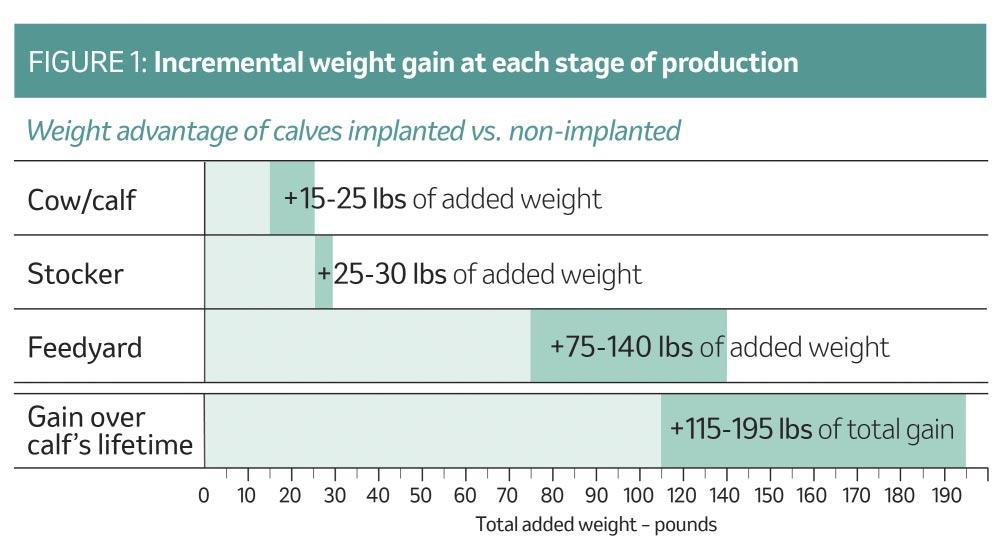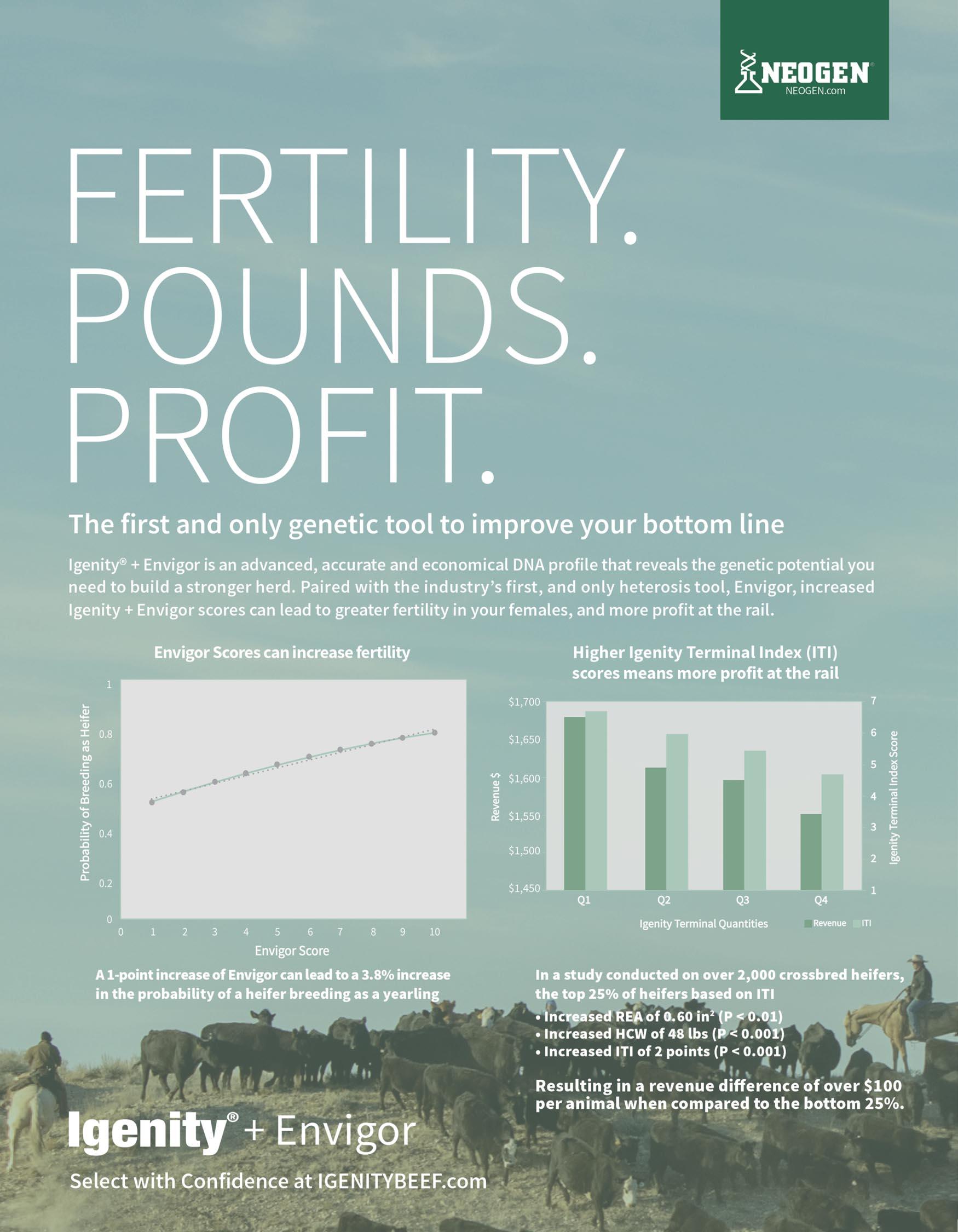
5 minute read
Evaluate economic impact of implants
By Wade T. Nichols, Ph.D., Senior Technical Services Manager, Merck Animal Health
Implanting is one of the most researched, proven and consistent cattle production technologies that improves sustainability, protects the environment and improves margin for the producer, while providing a safe and wholesome product for consumers. As a beef industry, we want to be good stewards of the land and continually strive to use resources more efficiently in order to improve productivity and profitability.
Implants are small pellets that release slowly over time and contain growth hormones, which are natural or comparable to the animals’ naturally occurring hormones that allow the animal to optimize growth naturally.
We typically castrate male calves. This removes the testes, which would have produced testosterone, estrogen and other hormones that naturally improve a calf’s growth rate over time. By implanting, we are allowing some of the natural growth processes that we would see in noncastrated animals.
These implants are placed under the skin on the backside of the ear because the ear does not enter the human food supply. Implants help improve the natural ability of cattle to convert resources, namely feed and water, into live and carcass weight. They improve margin by both increasing gain and decreasing the cost of gain.
Weight gain is significant, additive
At the cow/calf level, calves implanted will have 15-25 pounds additional weaning weights than calves not implanted. For an investment of approximately $1.50 per head, implants result in a $30 to $40 increase in calf value in today’s market. 1 At $30 per head implants exhibit a return on investment of 19:1. Implants are the most cost-effective way to improve margin and sustainability. Steers and cull heifer calves that are destined for finishing and sale to a terminal market should be implanted.
The effect of each implant is additive throughout the various segments of the beef industry. The margin and sustainability within each segment will be improved. The stocker and feedlot segments exhibit even greater responses than nursing calves. Research has proven that cattle given the correct implants on the ranch, or within each segment, will continue to perform at the next stage.
At the stocker or backgrounder, overall added weight gain depends on how long cattle are on grass, but ranchers typically see an additional weight gain of 25-30 pounds. At the feedyard, implanted cattle will gain an additional 60-90 pounds of carcass weight or 75-140 pounds of live weight over non-implanted cattle with no additional resources. Implants assist the producer to do “a lot more, with a lot less”, which improves sustainability and margin throughout the industry.
As an example of doing more with less: An implanted calf gains an additional 20 pounds and at weaning is put into a backgrounding program where it gains an additional 30 pounds, and is then fed to finish where it gains an additional 100 pounds. This equals 150 pounds additional weight while basically utilizing the same amount of resources as a non-implanted animal.
Figure 1 illustrates graphically the incremental weight gain advantage with the use of implants over a calf’s lifetime. Figure 2 illustrates the sustainability benefits of using implants.
Implants have been on the market for more than 60 years, and there have been varying degrees of use among the cattle segments. Perhaps the biggest barrier is the concern that implanted cattle may be discounted at the ranch level and to what extent.
A study published in 2019 looked at sale prices of beef calf lots enrolled in the nonhormone treated cattle (NHTC) program and those that received implants – sold through 67 summer video auctions from 2010 through 2018.2 There were 40,941 lots of beef calves used in the analysis.
The percentage of lots enrolled in the NHTC program grew from 5.2 to 23.8 percent over those nine years. The added value for a lot of beef calves enrolled in the NHTC program ranged from $1.02/100 lbs in 2013 to $4.04/100 lbs in 2014, indicating an increase in value over time. However, when comparing NHTC and implanted lots of cattle, the implant status did not result in a price reduction in any year, indicating no price difference between implanted lots and NHTC lots of cattle. While the percentage of NHTC lots grew, there was not a corresponding decline in the value of implanted lots.
Unless calves ultimately will be marketed in verified NHTC programs that offer a premium that outweighs the productivity and efficiency of gains from implants, calves that are destined for finishing and sale to a terminal market should be implanted. While NHTC programs are very good for some segments and offer a premium over the margin improvement that implants exhibit, they lose the sustainability factor for the environment.

Implementing the right implant program
The first step is to take into consideration your marketing program, preferably in consultation with your nutritionist. For a market demanding a leaner beef product, a more aggressive implant pro gram with high potency combination implants given early and re-implanted will yield maximum performance and lowest cost of gain. These cattle will also grade, but you need to feed them to the correct end-point, which requires heavier weights.
High quality markets may require a less aggressive implant strategy or longer feeding periods and heavier weights. A more moderate implant strategy offers the ability to maintain carcass quality without giving up a large performance response. Various implant strategies require the use of different implants with different potencies, so consulting your nutritionist will assist in choosing the correct program for each marketing strategy.

Implant products are available for use in nursing calves, stocker cattle and feedlot cattle. Most implants are specifically designed for a certain sex, age or stage of production, and can vary in terms of their strength, hormone ratios and duration of activity. Several newer implants offer extended release, which can reduce or eliminate the need for a re-implant program in a typical feedlot situation.
For an optimal return on investment, implants should be administered safely, accurately and effectively under the skin on the outside of the animal’s ear. Training and education in regards to animal handling, precision application, and sanitation are paramount to successful implanting.
Implant manufacturers, such as Merck Animal Health, consultants and in-house personnel often work with crews to provide training and conduct regular checks to help ensure implants are properly placed. When crews pay close attention to details and use proper techniques, they typically see a significant improvement in the number of good implants placed. Missing implants can cost producers significant losses in terms of performance and sustainability, so taking the time to use proper procedures and check implants is definitely worth the time and effort.
Consult your nutritionist
By using implants, you can be assured that you’re going to improve cattle performance and will be “doing a lot more with a lot less” – whether it’s a calf coming off the cow at weaning, the backgrounding phase or in the feedyard. Because of the various implant options available, it can be helpful to consult with your nutritionist and/or implant manufacturer to design an implant program for maximum benefit.

References
1. Selk, G. (1997) Implants for Suckling Steer and Heifer Calves and Potential Replacement Heifers. Proceedings: Impact of Implants on Performance and Carcass Value of Beef Cattle. Oklahoma State University, P-957. Pg 40.4. Superior Livestock Sale data report 2018.
2. McCabe, E., King M. Fike, K., Smith M. Hill, K. Effect of implant status and non-hormone treated cattle status on sale price of beef calves-Superior Livestock Video Auction. Journal of Animal Science , Volume 97, Issue Supplement S2, July 2019, Page 7, https://doi.org/10.1093/jas/skz122.012
Implants: Sustainable but are they safe?
The U.S. Food and Drug Administration (FDA) regulates the use of all growth-promoting implants to ensure that meat from animals given implants is safe for human consumption. Beef from steers and heifers fed for slaughter have a very low level of estrogenic activity, regardless of implant status. Table 1 shows the estrogenic activity of foods commonly consumed. Many common foods are naturally much higher in estrogen than implanted beef.













